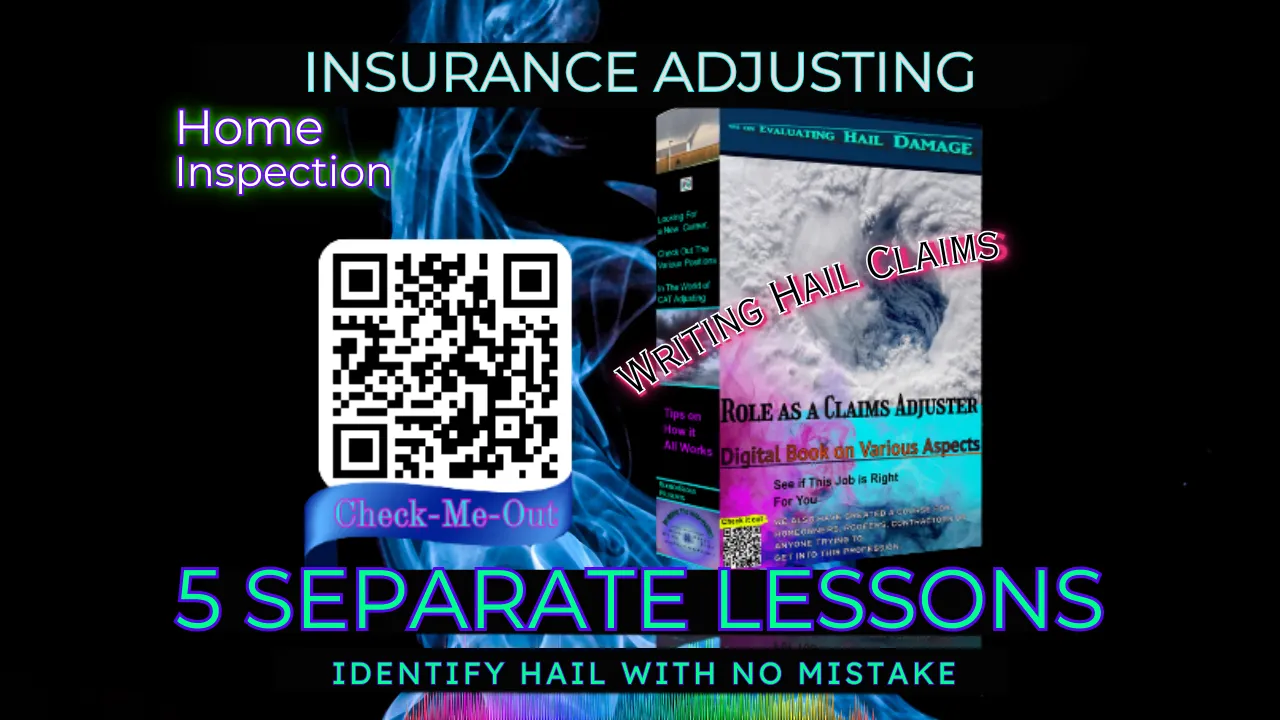Mastering Roof Inspections
Mastering Roof Inspections: Correctly Identifying Hail Damage
Ensuring accurate roof inspections is crucial for customer retention and positive referrals. Our course is designed for homeowners, adjusters, roofing assessors, and anyone looking to confidently assess roof damage. This comprehensive e-course covers essential topics such as:
- Rope'N'Harness Techniques
- Exterior and Interior Inspection Procedures
- Ladder Safety
- Identifying Hail Damage vs. Other Damage (e.g., wind)
- Plus writing scope in Xactimate Code, Templates on just about every step of a property inspection.
By completing this course, you’ll be able to accurately identify roof damage and make correct assessments every time, just as I did when I learned. You can too!
It's crucial to know how insurance adjusters do it because if there's damage that qualifies for insurance coverage, it needs to be found and recorded based on their criteria. When this happens, everybody is happy.
Click on the image above and take a closer look at what is all covered and the amount of information you will receive.
Mr. Krebs, a 15yr veteran CAT adjuster explains what he has learned and helps you build a solid foundation from which you can build your future on.
Test Squares:
Test squares play a critical role in assessing roof damage. Measuring 10 feet by 10 feet, these squares provide a standardized method for documenting the extent of damage, ensuring consistency across assessments. While a square shape is preferred, adjustments are made to accommodate irregular roof shapes. Regardless of shape, the test area remains constant at 100 square feet, facilitating accurate damage evaluation.
Placement of test squares is strategic, with consideration given to areas exhibiting the most damage. Each roof slope is assessed, ensuring comprehensive coverage. However, caution is exercised to avoid placing test squares in areas shielded by overhanging tree branches or other obstructions, which may obscure damage.
Following square placement, the adjuster meticulously tallies the number of hail strikes within each square.
These strikes must meet the criteria for functional damage, as defined by insurance companies, which I explain in detail along with a host of imagery to help you understand. The threshold for damage replacement varies among insurers, with eight hits being a common benchmark.
In summary, mastering the assessment of hail damage requires proficiency in utilizing test squares, understanding their significance in documenting damage severity accurately. By adhering to standardized procedures and criteria, professionals ensure thorough evaluation and fair resolution in insurance claims.
Number of Hits:
Determining the Number of Hits is a crucial step in assessing hail damage. Once the test square is in place, the adjuster meticulously counts the hail strikes within the square. These strikes must meet the criteria for Functional Damage, as defined by insurance companies. It's important to note that the Number of Hits required for replacement varies among insurers. Some may have different policies, but Eight hits is a common benchmark.
When considering Slope/Roof Replacement, various factors come into play. The decision to replace individual slopes or the entire roof depends on multiple considerations. The age of the roof is one significant factor; older roofs are more likely to require replacement. Additionally, some insurance companies employ a formula to assist in making this decision.
"Resolving Disagreements"
Certainly! In the context provided, "Resolving Disagreements" refers to the process of settling disputes that arise between various parties involved in insurance claims related to roof damage. These disputes may involve disagreements over the extent of damage, coverage eligibility, or adherence to contract terms.
The "Insurance Policy" serves as the guiding document outlining the terms and conditions of the insurance agreement. It includes provisions for settling disputes, such as arbitration clauses. Arbitration involves the appointment of representatives by both the policyholder and the insurance company, who, along with a mutually agreed-upon third party, work together to resolve the disagreement. This process often considers reports and assessments provided by professionals like roofers and home inspectors to reach a fair determination.
While arbitration is one method of resolving disputes, it's noted that this process is not frequently utilized. Instead, policyholders may opt to escalate their concerns by lodging complaints with the state's Department of Insurance. This department oversees insurance practices and ensures compliance with contract terms. Although they cannot compel payment without sufficient evidence of roof damage, they can advocate for the policyholder and encourage the insurance company to fulfill its obligations.
If the disagreement persists and the policyholder believes the insurance company has breached the contract, they have the option to pursue legal action. This involves hiring an attorney to represent their interests and filing a lawsuit against the insurance company to seek resolution through the court system.
Overall, the process of resolving disagreements in insurance claims involves various steps, including arbitration, regulatory oversight, and legal recourse, all aimed at achieving a fair and equitable resolution for all parties involved.
Conclusion:
Mastering the art of roof inspections, particularly when it comes to identifying hail damage, is essential for ensuring accurate assessments and maintaining customer trust. Our comprehensive e-course is designed to equip homeowners, insurance adjusters, roofing assessors, and other professionals with the necessary skills and knowledge to make precise evaluations.
By understanding and implementing techniques such as Rope'N'Harness, exterior and interior inspection procedures, and ladder safety, you can confidently differentiate between hail damage and other types of damage like wind. Learning the criteria used by insurance claims adjusters, such as the proper use of test squares and recognizing functional damage, ensures that you can provide reliable assessments that align with industry standards.
Moreover, understanding the mechanisms for resolving disagreements—ranging from arbitration to legal actions—further empowers you to navigate the complexities of insurance claims effectively.
With these skills, you will not only enhance your professional capabilities but also ensure the satisfaction and trust of your clients. Whether you're a seasoned professional or new to the field, this e-course offers invaluable insights and practical knowledge to help you succeed in every roof inspection you undertake. Remember, accurate identification and assessment of roof damage is not just a skill, but a critical component of providing top-quality service in the roofing and insurance industries.
"Continue to learn and grow in the field of Adjusting!"
GoldWiz & HTW2




